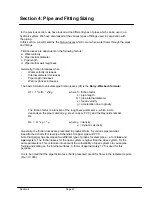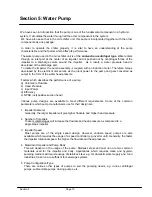
Section 5: Water Pump
We have seen in Introduction that the pump is one of the fundamental component in a hydronic
system. It circulates the water through all the other components in the system.
We have also seen that in the mini-chiller unit, this pump is incorporated together with the other
components as one package.
In order to operate the chiller properly, it is vital to have an understanding of the pump
characteristics and the factors which affect its performance.
The water pump used in the mini-chiller unit is of the
end-suction centrifugal type
. Water enters
through an inlet port at the center of an impeller and is pushed out by centrifugal forces of the
impeller to a discharge volute around the impeller. As a result, a water pressure head is
developed at the discharge port.
To rotate the impeller, the pump assembly is coupled with an induction motor. Therefore, torque
developed by the electric motor serves as the input power to the pump and gets converted as
output in the form of the water head pressure.
Factors which describes the performance of a pump:
a) Volumetric Flowrate
b) Head Pressure
c) Input Power
d)
Efficiency
e) NPSH (nett positive suction head)
Various pump designs are available to meet different requirements. Some of the common
parameters which pump manufacturers use for their design are:
1. Impeller Diameter
Generally, the larger impeller will give higher flowrate and higher head pressure.
2. Number of Impellers
These multiple stages will increase the flowrate and head pressure as compared to a
single stage impeller.
3. Impeller Speed
Most pumps are of the single speed design. However, variable speed pumps are also
available which requires the usage of a speed controller (e.g.inverter unit). Generally, the faster
the impeller rotational speed, the higher the flowrate and head pressure.
4. Material of Impeller and Pump Body
This will depend on the usage of the pump. Stainless steel and cast iron are two common
materials used for the impeller and body. Applications which requires clean and hygienic
pumping medium will require usage of stainless steel, e.g. for domestic water supply and food
industries. Cast iron are sufficient for sewerage systems.
5. Pump Configuration/Type
There are various other types of pumps to suit the pumping needs, e.g. in-line centrifugal
pumps, submersible pumps, dosing pumps, etc.
Section 5
Page 73
Summary of Contents for AC 40A
Page 1: ...AM MAC ...
Page 153: ...Appendix 1 ...
Page 154: ...Appendix 2 Appendix 2 ...
Page 157: ...GRAPH OF PRESSURE DROP VS FLOW FOR VARIOUS C V RATINGS Appendix 5 1 ...
Page 158: ......
Page 159: ...Water Capacity Graph Appendix 5 2 ...
Page 160: ...CHART 3 FRICTION LOSS FOR CLOSED PIPING SYSTEMS Appendix 6 1 ...
Page 161: ...CHART 4 FRICTION LOSS FOR OPEN PIPING SYSTEMS Appendix 6 2 ...
Page 162: ...CHART 5 FRICTION LOSS FOR CLOSED AND OPEN PIPING SYSTEMS Appendix 6 3 ...
Page 168: ...Appendix 8 Appendix 8 ...
Page 169: ...Appendix 8 1 ...
Page 170: ...Appendix 8 2 ...
Page 171: ...Appendix 8 3 ...
Page 172: ...Appendix 8 4 ...
Page 173: ...Appendix 8 5 Appendix 8 5 ...
Page 174: ...Appendix 8 6 Appendix 8 6 ...
Page 175: ...Appendix 8 7 Appendix 8 7 ...
Page 176: ...Appendix 9 ...
Page 178: ...Appendix 11 1 Appendix 11 1 ...
Page 179: ...Appendix 11 2 Appendix 11 2 ...
Page 180: ...Appendix 13 ...
Page 181: ...Appendix 13 1 ...
Page 182: ...Appendix 14 Appendix 14 ...
Page 183: ...Appendix 15 1 Appendix 15 1 ...
Page 186: ...Appendix 17 Appendix 17 ...
Page 187: ...Appendix 18 ...
Page 188: ...CE20DW CE25DW Note PRESSURE DROP CORRECTION FACTOR 1 2947 0 0021 EWTºF Appendix 19 ...
Page 189: ... 2003 McQuay International 603 55194922 www mcquayup com ISO 9002 REGISTERED ...
















































